by Julie Pigott Dillard | Jan 3, 2022
The Northwest District 4-H Teen Retreat is back and promises to be better than ever!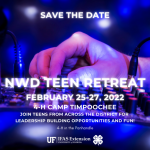
Planned FOR 4-Hers BY 4-Hers, the weekend long retreats features leadership building and fun workshops for 12-18 years old youth.
Mark your calendars for February 25-27, 2022, and register NOW in 4honline for the NWD 4-H District Teen Retreat at 4-H Camp Timpoochee.
Friday’s Schedule
6:00-7:15 pm – Check-in & pizza
7:15pm – Welcome & District Intros
8:00 pm – Campfire
Saturday’s Schedule
8:30am – Breakfast
9:15am – Group Pic
9:30-11:30am – Workshop Sessions
12:00pm – Lunch
1:00-2:45pm – FUNshop Sessions
3:00pm – Rec Time – 4-Hers vs Agents Kickball & Nine-Square
5:00pm – Service Project
6:00pm – Dinner
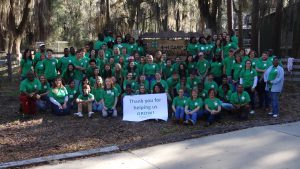
2019 Teen Retreat
7:00pm – District & State Events Reports
7:30pm – Dance, Games & Snacks
9:00pm – Music, Campfire & Smore’s
Sunday’s Schedule
7:00pm – Rise & Shine, pack-up
FUNshop Sessions – when you register, you’ll rank your top three choices from the list below:
- TikTok & Line Dancing
- Shooting Sports
- Drawing
- Grilling
- Cake Decorating
Packing List
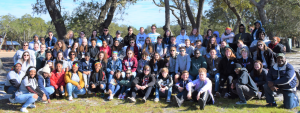
2020 Teen Retreat Participants
- Sheets, blanket & pillow
- Towel, toiletries & shower shoes
- 2-3 changes of clothes & sleep clothes – be sure to check the weather and be prepared!
- Daily meds – Put all OTC and Rx meds in a large ziploc bag and give to your 4-H Agent.
- $ for camp store, snacks & drinks while traveling
Your 4-H Agent will coordinate county travel to and from the event, and you should check with them if you have specific questions. We can’t wait to see you at the 2022 NWD 4-H Teen Retreat!
by pmdavis | Dec 16, 2021
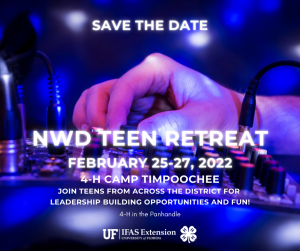
4-H Music Magic Teen Retreat
February 25-27, 2022
We are so excited to be able to offer a face-to-face teen retreat “4-H Music Magic” February 25-27, 2022! Join 4-H teens and faculty from the panhandle of Florida to learn new skills in a fun and educational way. Teen youth are encouraged to participate in the weekend filled with fun and hands-on experiences. Feel free to invite your friend that are not in 4-H already. They will just need to join. At the conference you will have the opportunity to network with 4-H educators and other volunteers to help you become a stronger 4-H member.
The conference registration will be open until February 7. The cost is $120 per person, paid to your county office. Some scholarships are available talk to your local 4-H Faculty member if you need financial help to attend. You will be required to register through the 4-H Online, under events labeled NWD 4-H Teen Retreat.
During the registration process you will be ask what your workshop/funshop preferences are for more information about these and a tentative schedule can be found on the 4-H DII website. For more information contact your local Extension Office!
by pmdavis | Dec 13, 2021

Meet Chris Lauen
“There’s No Place Like Holmes” – a phrase used in recent years to celebrate the opportunities that exist here in Holmes County, Florida. I find that many people try to figure out where our county is. Many locals say we are located right between Pensacola and Tallahassee, east and west– as well as Panama City Beach and Dothan, Alabama, north and south – right on the I-10 corridor. Many people know our community for our large annual rodeo, but most people out of state know we are their pathway to “The World’s Most Beautiful Beaches”. As a rural county with limited infrastructure, many young adults move elsewhere before realizing just how good of a place Holmes County is to raise a family and do life. I like to say, “The grass is green where you water it and my family and I choose to water it here.” Holmes County is growing and Holmes County 4-H will continue to do so as well.
My name is Chris Lauen and I grew up in the heart of Holmes County. One could even say it was the heart of Bonifay, the county seat, as my childhood home initially sat a few blocks from historic “downtown area”. Our home sat right on Highway 79 and faced the First Baptist Church. It was nestled next to the old Woman’s Club building and a “stones throw” from the Courthouse, Western Auto, and the “old” Bank of Bonifay. When the Bank of Bonifay (now First Federal Bank of Florida) chose to purchase the property from the church where my father was employed, my family ended up moving the home do a different property on the edge of town. That’s right – I managed to live in the same house with two different addresses. My weekly schedule as a child consisted of early mornings and late afternoons at Bonifay Elementary because that’s where my mom spent much of her career as the music teacher. Sundays were not much different as she typically played piano at First Baptist where my father has served as Minister of Music, Administrative Pastor, and a few other titles during my lifetime. My two older siblings would describe similar childhood experiences and still call Holmes County home, but reside with each of their families outside of Atlanta.
As I reach my middle school years, I would travel all over town as far as my bicycle or roller blades would take me, but my real playground was around any water that might have a fish hiding inside. I would bounce between the local ponds and creek and even prided myself in being able to catch some fish out of the ditches in the front of my home. My family supported my love for fishing and I’ll always remember my first days of surf fishing in Destin and my first trips on party and charter boats. I remember the sight of all of the big boats lined up at the harbor, the smells of diesel fumes from the engines wafting through the air combined with the odor of fish from the morning catch, and the overwhelming feelings of excitement about new adventures. For me, a driver’s license meant that I could find even more fish to catch, but also opened the door for more passions as my grandfather and great uncle passed down their old Browning A5 shotguns and a 1917 rifle. I enjoyed my new pursuit of new species, learning how to trap hogs, figuring out the best ways to get ducks to decoy, and looking for that big whitetail buck. With a driver’s license and other church members and mentors that liked to hunt and fish, I always tried to have a box of ammunition or fishing pole within reach. In the years ahead, my life revolved around school, hunting, fishing, attending or teaching at youth camps, foreign mission trips, playing music, and serving at our church.
Graduating from high school meant that I had the credentials to be a substitute teacher. With my mom still teaching and my history of literally growing up in and around the school, it didn’t take long for teachers to keep my calendar full based off their sick and vacation days. I was 17 years old. One week I was a student and somehow the next, a substitute teacher. I had the opportunity to attend Chipola College where I earned a degree in Professional Communication. I spent extra time on campus as a result of a Fine Arts scholarship and TV production scholarship. Whether it was running sound for the next big theatrical production or operating cameras at the athletic events, there were always opportunities to jump in, learn, and serve. After graduating from Chipola College, I went on to earn a Bachelor’s degree in Professional Communication as well as a Master’s degree in Corporate and Public Communication from Florida State University.

The Meet Family
In 2009, my days as a substitute teacher came to close as I accepted a position with the Florida Department of Health in Holmes County. From 2009-2021, I served in a few different capacities. My titles included Senior Human Services Program Specialist, Certified Contract Manager, Webmaster, and Public Information Officer. My responsibilities as a Program Lead included the development of a county-wide partnership, including youth and adults, who would advocate for change across social, political, and legal landscapes. We worked with key decision makers, elected officials, and the general public to promote healthy living for generations to come. While serving at the Department of Health, I actually had the opportunity to serve on the local Holmes County 4-H Advisory Council and even had some of our youth partner with Holmes County 4-H on some projects.
Here I am today, my family and I are starting a new chapter with 4-H and Holmes County. In ways the work is similar to what I’ve been doing for years, but in many ways – it’s different. It’s exciting to have a new platform to serve my community. I’ve been blessed with an entrepreneurial, music singing/playing, horse riding, water sport loving, wife who I met through an annual church music camp that both of our parents taught at. In my very biased opinion, we have two spectacular kids who also love the outdoors and bring us lots of joy. Our little girl, who is currently in 2nd grade, has an amazing heart and is super witty. She is very excited about her dad’s new job because she is a huge fan of arts and crafts, cooking, and music. She learned how to sleep on the front deck of a boat at an early age and already has her lifetime fishing and hunting license. Our little boy just turned two and loves a good hardback book. He’s learning new words every day, but mainly prefers to use the books as a ramp for his cars and monster trucks to drive over, around, and under. If there is a mud puddle within sight, you better hold him tight or he will be in it. As my kids grow older, I’m excited about the prospect of their future 4-H involvement.
As the new Holmes County 4-H Agent, I look forward to “making the best better” and working toward the 4-H vision of creating positive change in our youth, their families, and our communities. I guess I can say “that grass” my family is watering now includes 4-H.
We look forward to watching Holmes County 4-H grow!
by pmdavis | Dec 1, 2021
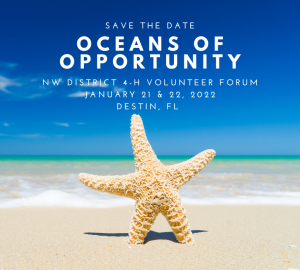
Oceans Of Opportunity Volunteer Forum January 21-22, 2022
We are so excited to be able to offer a face-to-face volunteer forum “Oceans of Opportunity” for our Panhandle Florida 4-H Volunteers January 21-22, 2022! Join 4-H volunteers and faculty from the panhandle of Florida to learn new ways to engage youth in 4-H programs in a fun and educational way. Teen and adult club volunteers, 4-H staff, and military and afterschool staff are encouraged to participate in the forum to explore new 4-H curriculum and activities, learn ways to make their 4-H programs more fun and meaningful, learn skills to re-energize your program after the pandemic and gain insights and bring back to your local program. At the conference you will have the opportunity to network with 4-H educators and other volunteers to help you become a stronger 4-H volunteer.
The conference registration will be open until December 22, 2021. You will be required to register through the 4-H Online, under events labeled Northwest Florida 4-H Volunteer Forum.
During the registration process you will be ask if you have a share fair/static displays that you would like to share during lunch on Saturday. This could be something that has worked well for you in the past that you are excited about. You may also include a make and take craft stations for other volunteers to experience making something, such as a 4-H pin, rocket, or hose ball. The make and take should be suitable for a 4-H club educational program. These stations will be available Friday evening, after keynote speaker and is a totally voluntary event.
The cost of the conference is $60 payable to your local extension office. A tentative schedule, and additional registration information can be found on the NW District Volunteer site.
by Allison Leo | Nov 29, 2021
4-H Day at the North Florida Fair celebrated a triumphant return on Saturday November 13. This annual event in Tallahassee took a hiatus in 2020 due to the pandemic but returned in full force this past Saturday. 4-H Day at the Fair is an event that connects 4-H members and their families with each other from across North Florida. The fair was filled with a sea of green as eager 4-H members joined together to compete in 4-H contests, enjoy fair rides, and sample delicious fair food. The North Florida Fair provides 4-H members and volunteers with special deals on rides for the day. 4-H Member Arvaneh G. shared that her favorite part was “all the rides, especially the Himalaya, and the bounce houses”.
Before the rides and fair are open, 4-H Day Starts in the early morning as members compete in a variety of contests. This year, those contests were the STEM Challenge, Consumer Choices, Agriculture Judging, Horticulture Identification, and Wildlife Ecology. Members put their life skills developed through 4-H to work by displaying critical thinking, teamwork, and problem solving during the contests. A total of 116 youth competed in the contests during 4-H Day at the North Florida Fair this year. Participants had the option to compete as individuals or on a team in each contest. Senior 4-H Member Sophia L. shared “it was really great to see the Wildlife Ecology Contest return, we had such a great turn out with a lot of variety in ages”. Sophia expressed how she was excited for the contest to be back, adding “there is something about that friendly competition atmosphere this is really motivating, seeing so many people that are all passionate about similar things”.
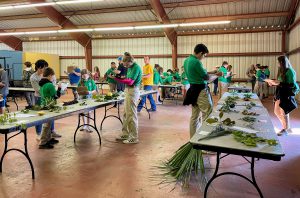
4-H members participating in the Horticulture ID Contest
STEM Contest
The topic of the STEM Challenge Contest this year involved building a roller coaster using the engineer design process. All youth competing in this contest were placed on a team based on their age division. A limited amount of materials were provided and the teams worked together to create a roller coaster that would carry a marble from the top of the coaster to the bottom with at least two loops and one curve. The teams were judged on creativity, communication, and teamwork. The final designs were put on display in the 4-H Building for the remainder of the fair.
Consumer Choices
The Consumer Choices Contest measured the ability of youth to be smart shoppers. The item categories this year were cell phone plans, ground transportation selection, wireless portable speakers, and smoothies. 4-H members had the opportunity to compete in this contest as an individual or on a team. Each individual or team was provided with a “situation card”. Based on the criteria provided in the card, members were asked to review four different choices of each item and rank them from best to worst based on the criteria. After they were finished ranking, they would have to justify their selection through an “oral reasoning” section.
Agriculture Judging
During the Agriculture Judging Contest, individuals and teams were tested on their knowledge of beef, poultry, hay, corn, soybean, and oats. Youth competed both as individuals and on teams with their age division. Agriculture judging consists of analyzing a product (i.e. cattle, soybeans) and measuring it against a standard. Members were asked to analyze four different choices of each item and rank them from best to worst based on the standard.
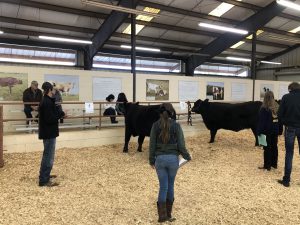
4-H members competing in the Agriculture Judging Contest
Horticulture Identification
The Horticulture Identification Contest tested the ability of members to identify over 60 horticulture specimens. The items were divided into four separate categories. Those categories were ornamentals, fruits & vegetables, flowers, and foliage. The specimens were laid out on tables, each bearing a number that corresponds to a scoresheet, that listed over 100 plant names. This contest replicates the state 4-H Horticulture Contest held each year in June.
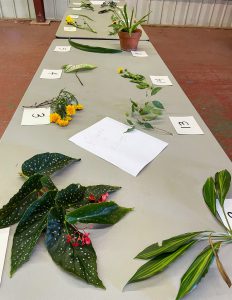
Plant specimens in the Horticulture ID Contest
Wildlife Ecology Contest
During the Wildlife Ecology Contest, members were tested on their knowledge of Florida trees, mammals, birds, reptiles, and amphibians. They identified the various items through pictures, physical specimens, and audio sounds. 4-H Member Joycelyn G. joined 4-H this past year and had the opportunity to participate in two contests this year. When asked what her favorite thing about 4-H Day at the Fair was, she answered “I loved the rides and I loved the competition. Thank you very much for having a special spot for me. I really loved the fair. It was the best day ever!”
4-H Exhibits & Club Booth Building
In addition to contests, members had the opportunity to view exhibits and club booths in the 4-H Building at the fair. 4-H members from across the panhandle submit exhibits that express what they have learned through their 4-H experience. Premiums and special merit awards are issued to members whose exhibits demonstrate outstanding efforts and quality in each class. Club booths are constructed by club members and volunteers. The club booths showcase the various 4-H clubs in North Florida.
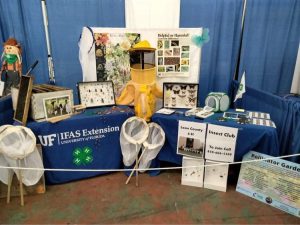
Leon County 4-H Insect Club created their booth to highlight the importance of pollinators
by pmdavis | Nov 5, 2021
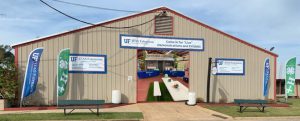
UF/IFAS Building at the NFF
The 79th Annual North Florida Fair began with exhibits coming in Monday and being judged on Wednesday. We would love you to come see what our industrious youth have been up to creating artwork, growing plants and sewing to create some one of a kind pieces. Thank you to our judges who volunteered their time to support our youth!

Allison orienting judges for the 4-H exhibit judging.
The 4-H experience is being showcase right now at the 2021 North Florida Fair in Tallahassee, Florida. The fair is open thru November 14th, we hope you will come by and visit us. Here you will have the opportunity to see the 4-H youth work and meet UF/IFAS Extension Faculty and Staff. There are two areas to visit with Extension professionals.
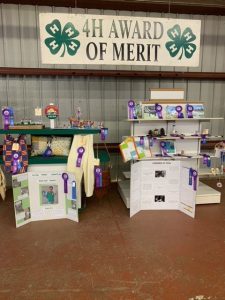
2021 Award of Merit Exhibits on Display at NFF
The first is the 4-H Building. In this exhibit you will find youth exhibits of artwork, sewing, canning, photography and much more. The second is the UF/IFAS Building where you can check out your marine science knowledge, learn about grains and grasses and amphibians. Youth will be participating in Beef, dairy, goat, poultry, and rabbit shows throughout the week. 4-H Day at the Fair is Saturday, November 13, 2021. From 10:00 a.m. – 12:00 Noon youth will be competing in agricultural judging, horticultural judging, wildlife ecology, consumer choices, stem challenge, sewing contests to demonstrate what they have learned about these specific topics.
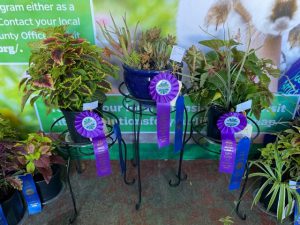
The top Award of Merit winners for plants from all three age divisions
4-H teaches youth responsibility, compassion, respect and the value of hard work. It helps youth become a confident kid and caring adult. We provide 4-H programs in every county in Florida. 4-H programs are offered in big cities, small towns, and rural communities, as well as on U.S. military installations. For more information contact your local extension office. Participation shall not be denied on the basis of race, color, religion, sex, national origin, disability, sexual orientation, marital or family status, or political beliefs. Persons with disabilities should contact the Extension Office at least 10 working days prior to the event so that proper consideration can be given to the request.
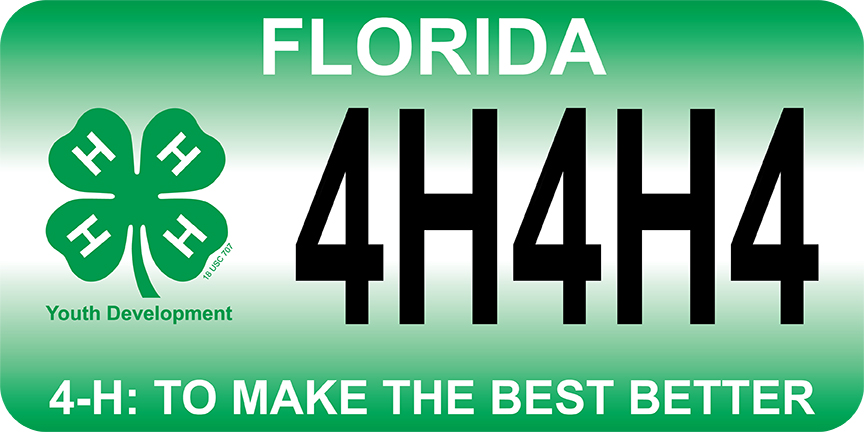
Help support by purchasing a 4-H Specialty Plate
You can help kids have the same great experience – share your #4HGrown story. You can also help your local 4-H program by purchasing a 4-H license plate. Vouchers for a new specialty license plate bearing the iconic 4-H clover is available for purchase at all county tax collector offices and license plate agencies in Florida or online (from anywhere in Florida) through the Escambia County Tax Collector’s Office. The license plate will go into production once 3,000 pre-sale vouchers are sold. The voucher, which includes the $25 specialty plate fee plus processing fees, is $33 total. Please consider purchasing your plate today, it would make a great Holiday present for those who grew up in 4-H!
















